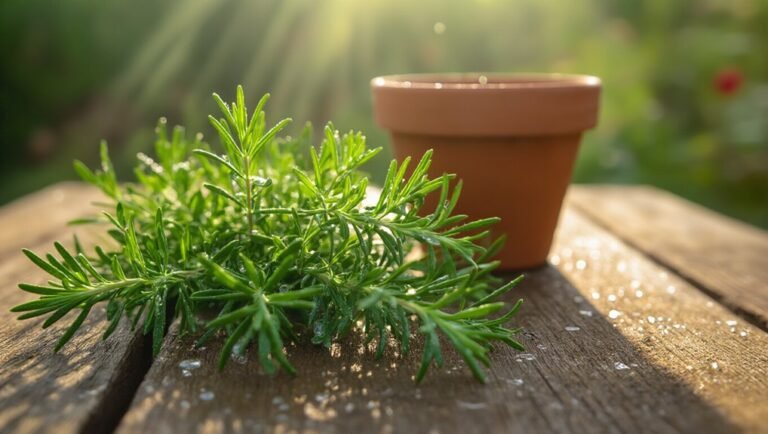To care for your rosemary plant, ensure it gets 6-8 hours of sunlight daily and thrives in temperatures between 60°F and 70°F. Use well-draining soil and water only when the top inch feels dry, about once a week. Prune in spring, cutting back one-third of the plant, and watch for pests like aphids and spider mites. Fertilize every 4-6 weeks at half strength. You’ll find more tips to keep your rosemary healthy and flourishing.
Key Takeaways
- Rosemary thrives in well-draining soil with a pH of 6.0 to 7.0; amend soil with sand or gravel for drainage.
- Water only when the top inch of soil is dry, typically once a week, to prevent root rot.
- Ensure rosemary receives 6-8 hours of sunlight daily and maintain temperatures between 60°F and 70°F.
- Prune in spring by cutting back one-third of the plant to encourage healthy growth and harvest regularly without over-harvesting.
- Regularly inspect for pests like aphids and spider mites; maintain good air circulation to prevent powdery mildew.
Ideal Growing Conditions for Rosemary

To thrive, rosemary needs specific growing conditions that mimic its native Mediterranean habitat. You should provide plenty of sunlight, ideally six to eight hours each day.
This herb loves warmth, so aim for temperatures between 60°F and 70°F during the day and slightly cooler at night. When planting, choose a location with good air circulation to prevent diseases. For best results, supplement your rosemary with plant fertilizer tablets to ensure it receives essential nutrients for robust growth.
Rosemary prefers a dry environment, so avoid overly humid areas. If you’re growing it indoors, place it near a south-facing window to maximize sunlight exposure.
Make sure you keep the plant away from drafts and extreme temperature changes. By creating these ideal conditions, you’ll encourage healthy growth and a bountiful harvest of flavorful rosemary.
For optimal results, consider nourishing your rosemary with the best plant food options to support its growth and overall health.
Soil Requirements and Preparation
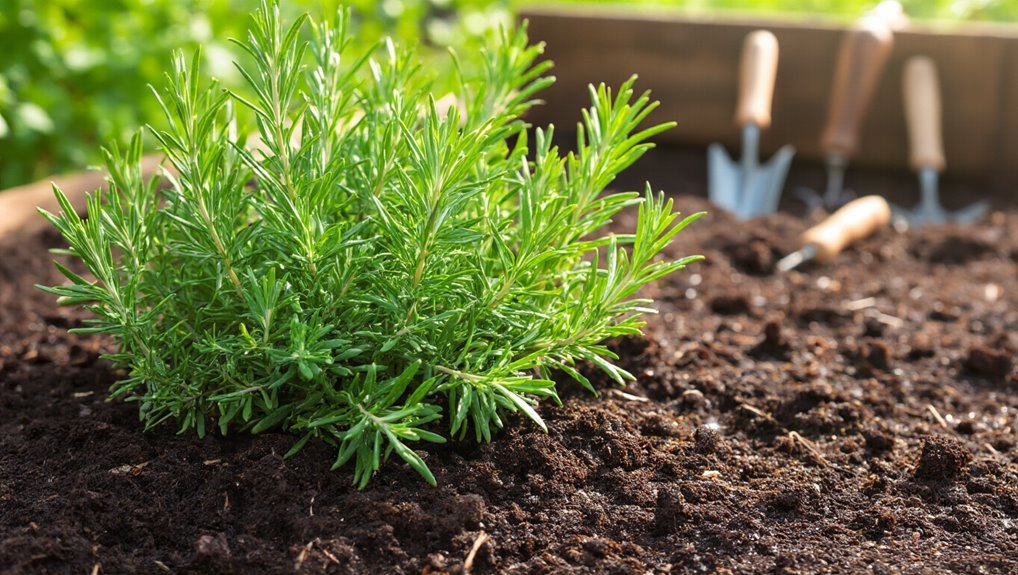
While rosemary thrives in well-draining soil, preparing the right mix is crucial for its success. Aim for a soil blend that combines equal parts potting soil, sand, and perlite or gravel. This combination ensures excellent drainage, preventing root rot.
If you’re planting in the ground, amend your soil with coarse sand or small stones to enhance drainage. Test the pH; rosemary prefers slightly acidic to neutral soil, ideally between 6.0 and 7.0. Using a garden hose reel can help manage your watering routine, keeping your garden organized and ensuring your rosemary receives the right amount of moisture.
Before planting, loosen the soil to promote root growth and remove any weeds or debris. If you’re using a pot, ensure it has drainage holes to further prevent excess moisture.
For efficient watering and soil maintenance, having essential garden hoses in your toolkit can make caring for your rosemary much easier and more precise.
With the right soil preparation, your rosemary can flourish and thrive in your garden or on your windowsill.
Watering and Fertilizing Rosemary
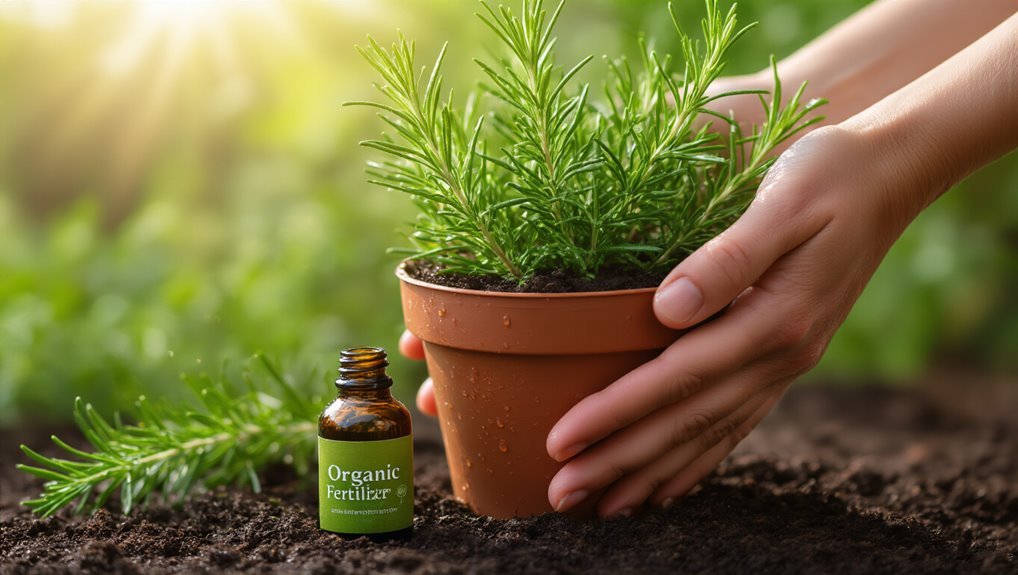
Watering and fertilizing rosemary properly is essential for its health and growth, especially since too much moisture can lead to root rot. To keep your plant thriving, water it when the top inch of the soil feels dry. This typically means you’ll water about once a week, but adjust based on your climate and pot size.
Be sure to use well-draining soil and pots to prevent excess water. You can maintain optimal soil moisture by using a wicking system, which provides a steady supply of water to the roots and reduces the risk of overwatering.
When it comes to fertilizing, rosemary doesn’t need much. Use a balanced, water-soluble fertilizer every 4-6 weeks during the growing season. Dilute it to half strength to avoid over-fertilizing.
For gardeners seeking more efficient watering, consider using drip irrigation systems to deliver moisture directly to the roots without overwatering. With these simple steps, you’ll help your rosemary flourish and enjoy its aromatic leaves for culinary delights.
Pruning and Harvesting Techniques

After ensuring your rosemary gets the right amount of water and nutrients, it’s time to focus on pruning and harvesting techniques. Regular pruning keeps your plant healthy and promotes bushier growth. Here are some tips to help you out:
- Prune in spring: Cut back about one-third of the plant to encourage new growth.
- Use sharp shears: Always use clean, sharp tools to prevent damage and infection. Many gardeners rely on essential weeding tools to maintain the health and appearance of their garden beds.
- Harvest regularly: Snip off sprigs as needed, taking care not to remove more than one-third at a time.
- Dry your herbs: If you’re harvesting a lot, hang the sprigs upside down in a cool, dark place to dry for later use.
For the best results when pruning, consider using essential pruning shears designed specifically for gardening tasks to make clean and effective cuts. With these techniques, your rosemary will thrive and provide flavorful additions to your dishes!
Common Pests and Diseases
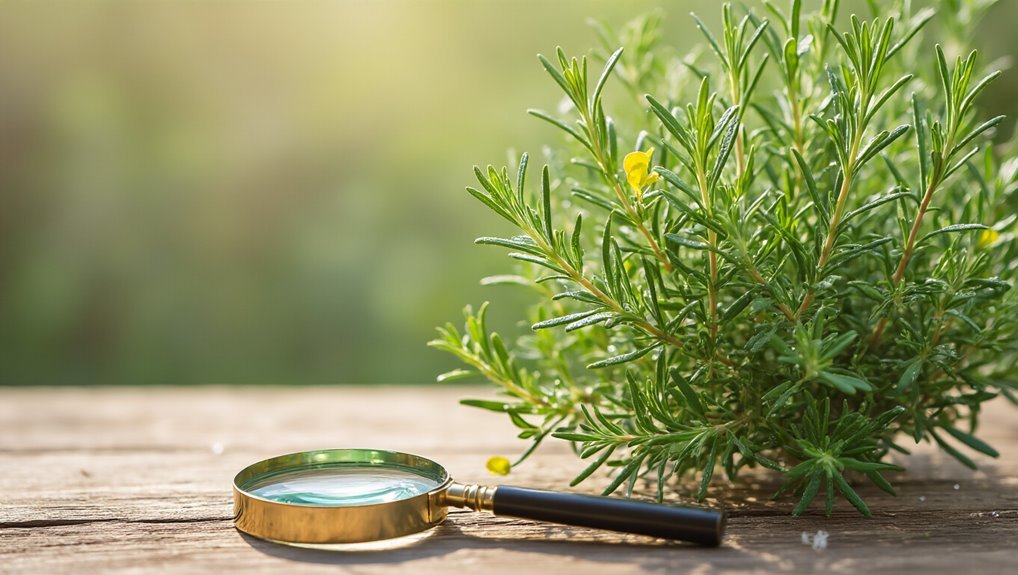
Although rosemary is generally resilient, it’s still susceptible to a few common pests and diseases that can affect its health. You might notice aphids, spider mites, and whiteflies feeding on your plants, causing leaves to curl or yellow. Regularly inspecting your rosemary can help you catch these pests early. For tougher infestations, pest control products are available to effectively manage unwanted insects and protect your plants.
Additionally, powdery mildew can develop in humid conditions, leading to a white, powdery coating on leaves. To prevent this, ensure good air circulation and avoid overhead watering.
Root rot is another concern, often caused by overwatering. Always check the soil moisture before watering and use well-draining soil.
For natural pest control, you can utilize Garden Pest Traps like sticky traps to reduce populations of common insects and keep your rosemary healthy.
Tips for Overwintering Rosemary
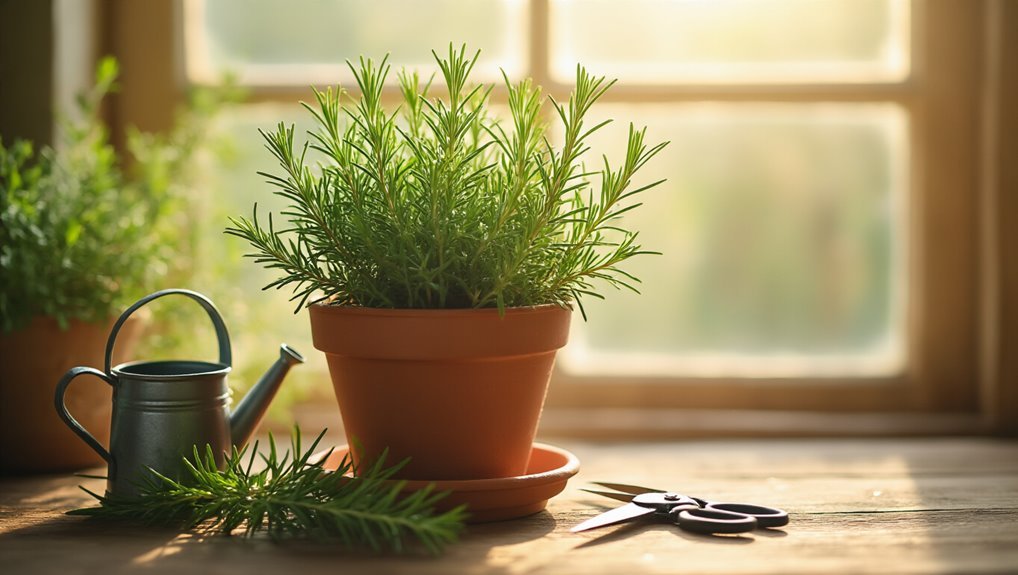
To successfully overwinter your rosemary, you need to take a few essential steps that will protect it from cold temperatures and harsh conditions.
Follow these tips to ensure your plant thrives through winter:
- Bring it indoors: If you live in a colder climate, move your rosemary pot inside before the first frost.
- Choose the right spot: Place it in a bright, sunny location, ideally near a south-facing window. Indoor rosemary is a wonderful addition to herb gardens, bringing fresh flavor and fragrance to your home throughout the year.
- Control humidity: Keep the air around the plant humid by misting it or using a humidity tray.
- Limit watering: Water sparingly during winter; rosemary prefers drier soil to prevent root rot.
For even easier care, consider growing your rosemary in self-watering planters, which help maintain consistent moisture levels and make winter care more effortless.
Frequently Asked Questions
Can Rosemary Be Grown Indoors Year-Round?
Yes, you can grow rosemary indoors year-round. Just make sure it gets plenty of sunlight, keep the soil well-drained, and maintain a consistent temperature. With the right care, your rosemary will thrive beautifully inside.
What Are the Best Companion Plants for Rosemary?
Imagine your kitchen garden thriving with rosemary and basil side by side. These companions not only enhance flavors but also repel pests. Pairing them boosts growth, creating a vibrant, aromatic space you’ll love nurturing.
How Long Does It Take for Rosemary to Mature?
Rosemary typically takes about 1 to 3 years to mature, depending on growing conditions. You’ll notice it thriving in well-drained soil and plenty of sunlight, which helps speed up its growth process significantly.
Is Rosemary Safe for Pets?
Imagine a garden filled with fragrant herbs, but you wonder if rosemary’s allure is safe for your furry friends. Luckily, rosemary’s non-toxic nature means your pets can safely roam among its aromatic leaves without worry.
Can I Propagate Rosemary From Cuttings?
Yes, you can propagate rosemary from cuttings! Just take a healthy stem, remove the lower leaves, and place it in water or soil. Keep it moist, and soon you’ll see roots developing. Enjoy your new plant!
Conclusion
With a little care, your rosemary plant can thrive, filling your garden with its aromatic scent and vibrant green leaves. You might worry about the effort it takes, but imagine stepping outside to a lush, fragrant herb that enhances your meals and elevates your space. By following these tips, you’ll not only create a flourishing plant but also enjoy the satisfaction of nurturing something beautiful and useful. So go ahead, let your rosemary flourish!


